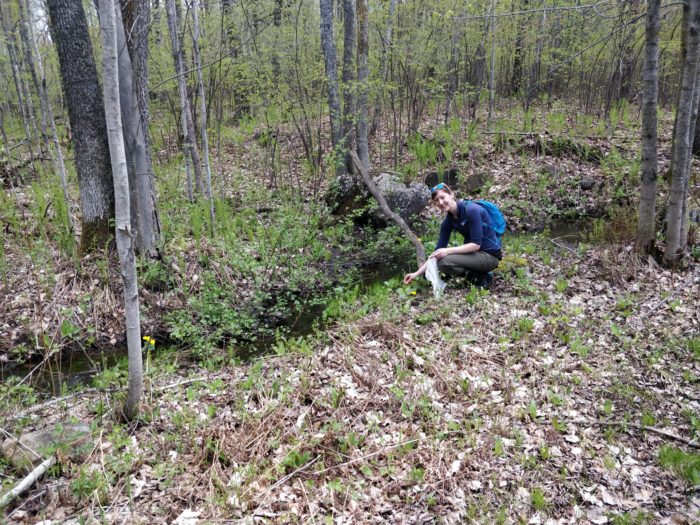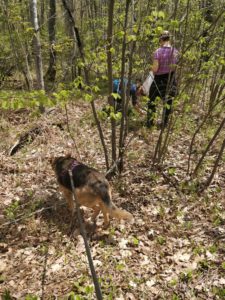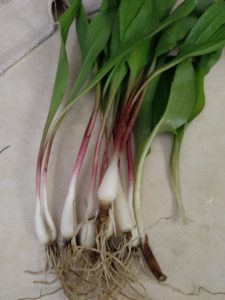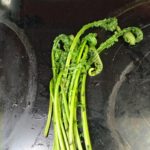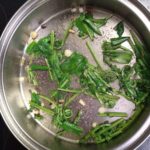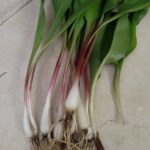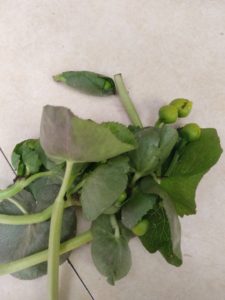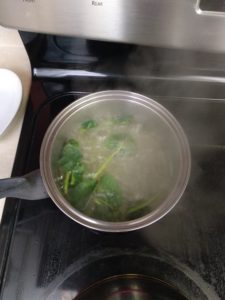Many people helped bring this month’s post to life. A special thank you to Kelley Haldeman, foraging guide extraordinaire, and to Nissa Peterson, who connected us. Thank you to Eric, for accompanying me in the woods, taking pictures, and keeping the pup occupied. Thank you to Charlie, Jean, Jessica, and Rosie for opening your home, letting us spend the night, and allowing me to fiddle around in the kitchen–you all are the best!
Also, a disclaimer: I am by no means an expert forager. Please consult an expert before trying to eat anything you find in the woods. Seriously.
Digging Into Foraging
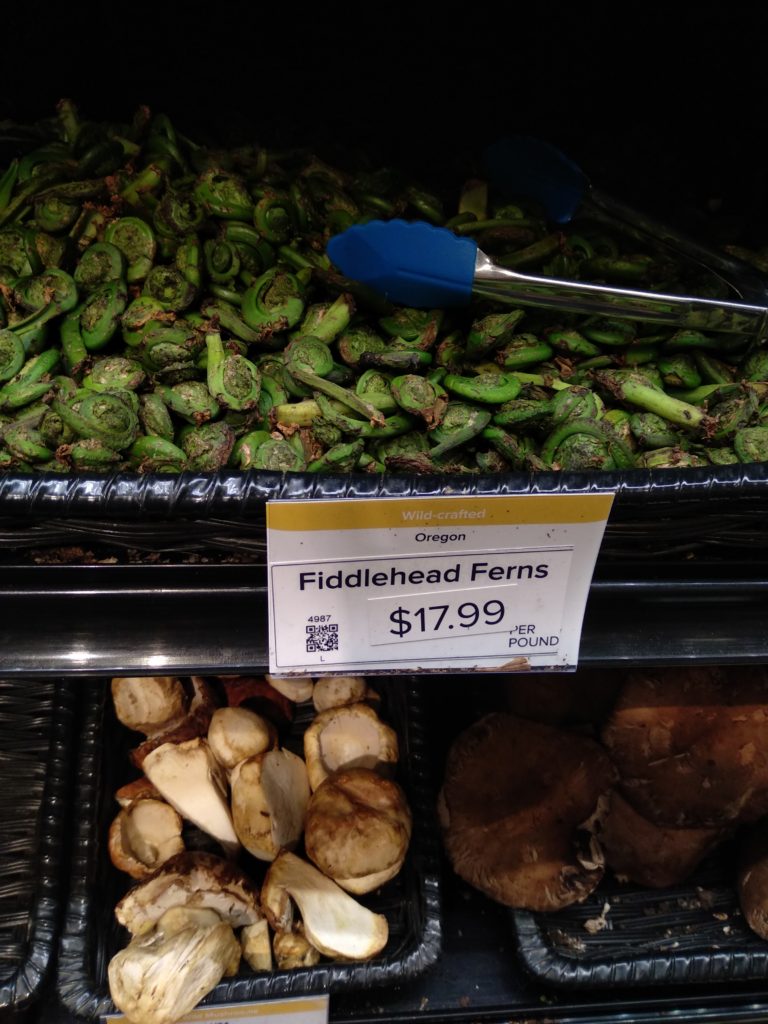
When I was young, my mom taught me how to eat the tips off the red columbine flower growing in our woods. I remember plucking them off the plant and popping them straight into my mouth. They tasted faintly of honey, but earthier and much less sweet.
At the end of our quarter-mile-long driveway, my brother and I would comb the ground for patches of wild strawberries. They were tiny things and it would take us ages to fill a small cereal bowl, but what else did we have to do during the early days of summer vacation? We would sit for hours, it seemed, and pluck the berries from the plant. I was a disciplined kid and would resist eating them until we hauled them back inside to show our mom.
Scattered amid the twenty-eight acres of my childhood were all kids of edibles—wild asparagus, raspberries, blackberries, and the tartest crabapples to ever touch your tongue. I grew up understanding how to forage, but I only harvested the obvious things—the things my parents pointed out. I didn’t bother to learn any more than that.
This past month, I figured it was time to dig a little deeper (literally) and learn how to forage from an expert.

Eric, Dobby (our pup), and I drove up to Duluth during a mild and sunny Memorial Day weekend to meet up with Kelley Haldeman, a friend of my college buddy Nissa Peterson. Though Kelley probably wouldn’t claim she’s an expert, she knows a heckuva lot about foraging in the Northwoods. She took us out on a trail and immediately starting pointing out ordinary-looking green plants that were fit for human consumption.
The first plant: Swamp Saxifrage
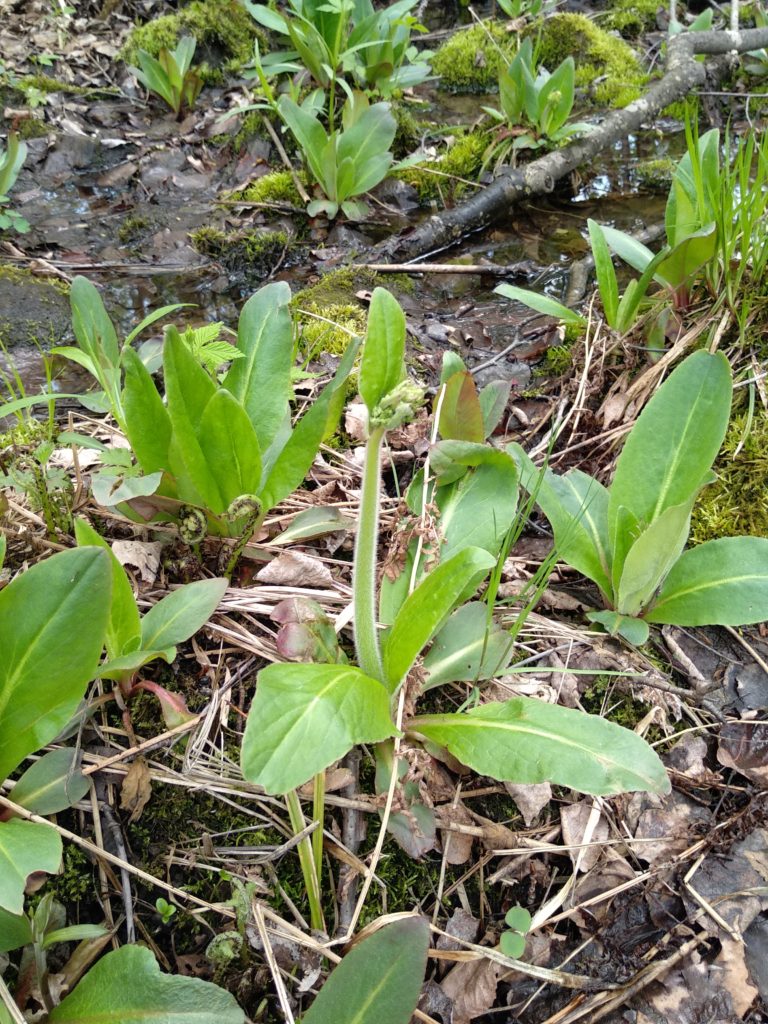
Even though Saxifrage is super common in Minnesota (and other parts of the northern U.S.), it is often overlooked as an edible. Honestly, I’m not sure why—this is nature’s green bean! When the plant starts to flower, it grows a long, green stem that can be snapped at its base and consumed raw (just don’t eat the flower). I was pleasantly surprised by its crisp texture and refreshing flavor—much like a green bean, as I mentioned, but a tad sweeter. The stem becomes a little more bitter as you approach the flower.
Second stop: Ostrich Fern fiddleheads
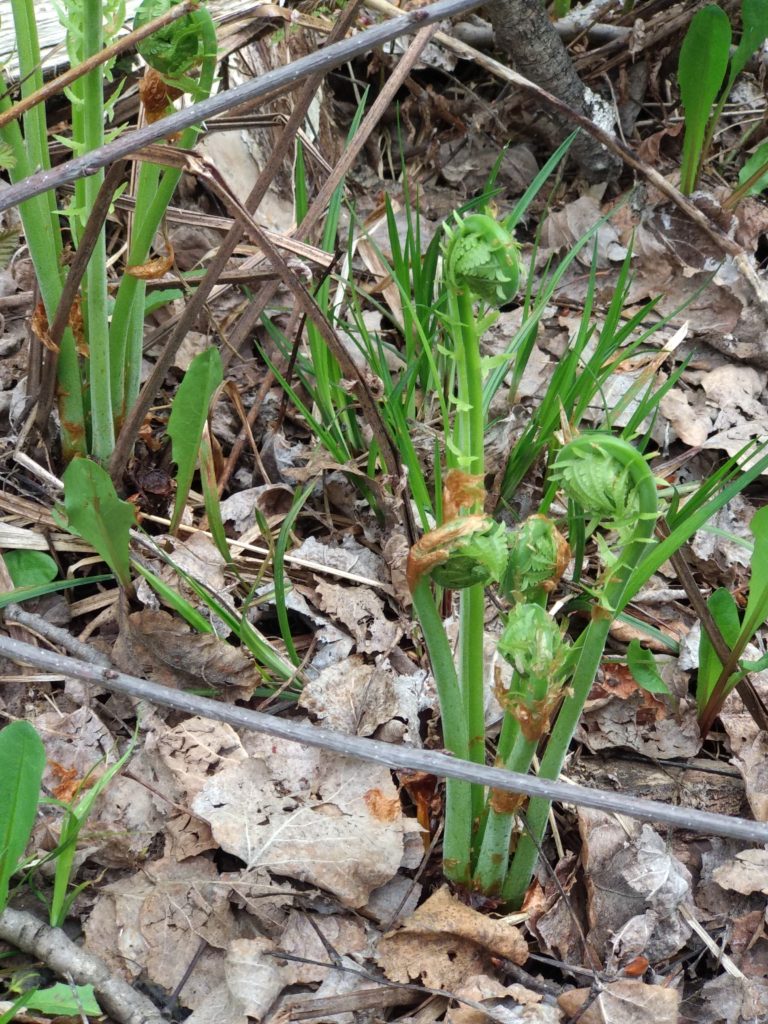
As we wandered down the trail, Kelley pointed out many types of ferns, including cinnamon and interrupted. Most ferns are unfit for human consumption, so it’s necessary to do your homework before venturing into the woods and picking the first ferns you lay eyes on. Plus, all ferns have a fiddlehead stage, so saying you’re after “fiddlehead ferns” is like saying you’re going to the bakery to buy a “pastry.” A cookie is different than an éclair, turns out.
There are a couple different types of fiddleheads you can eat, but the most common in Minnesota is the Ostrich Fern. Identify the Ostrich by the following features:
- Green stem
- Deeply lobed, full leaves
- A deep groove down the stem
- A gold-colored sheath that partially covers the fiddlehead
If the plant has started to unfurl, it’s too late to pick it. The best time to harvest is when the fiddlehead has emerged from the soil and has a stem that’s at least a couple inches high, with the head still tightly curled.
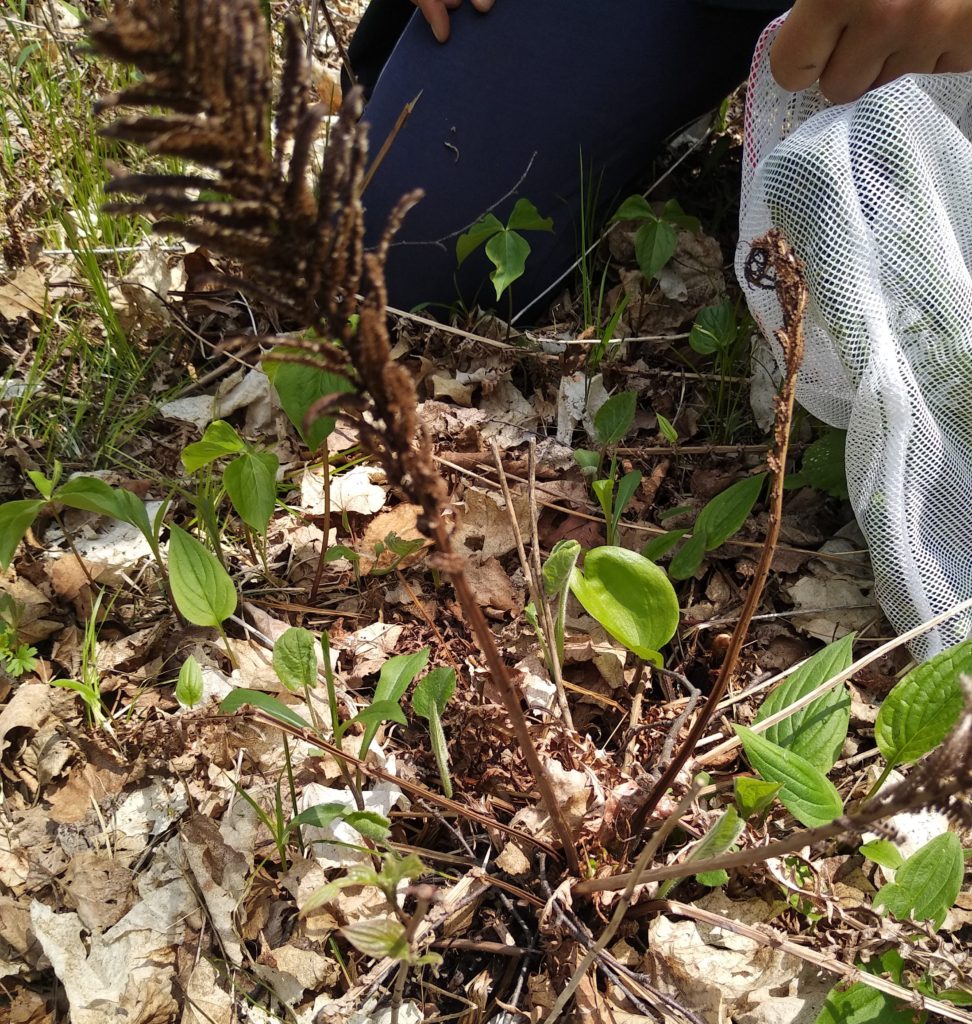
How do you happen to catch these ferns when they’re young? In the spring, try looking for the telltale sign of soon-to-be ostrich ferns: their spore. Ostrich ferns have a distinct brownish spore that pokes about a foot out of the ground and has a bristly top. According to MinnesotaWildflowers.info: “These fertile fronds are initially green but turn dark brown with maturity and persist through the winter, releasing spores the following spring before dying back.”
HARVESTING ETIQUETTE
I think it’s time to insert a little harvesting etiquette. Kelley was adamant about not over-harvesting our foraged finds. When we found ramps, she suggested we dig out one or two bunches and leave the rest so they’ll come back next year, and the year after that. When we harvested fiddleheads, she recommended taking two or three heads from a single cluster (of about six), so the others could mature and grow.
The principal here is simple: don’t overharvest. Leave some plants to ensure the continued growth of the species.
Third Stop: Yellow Marsh Marigold
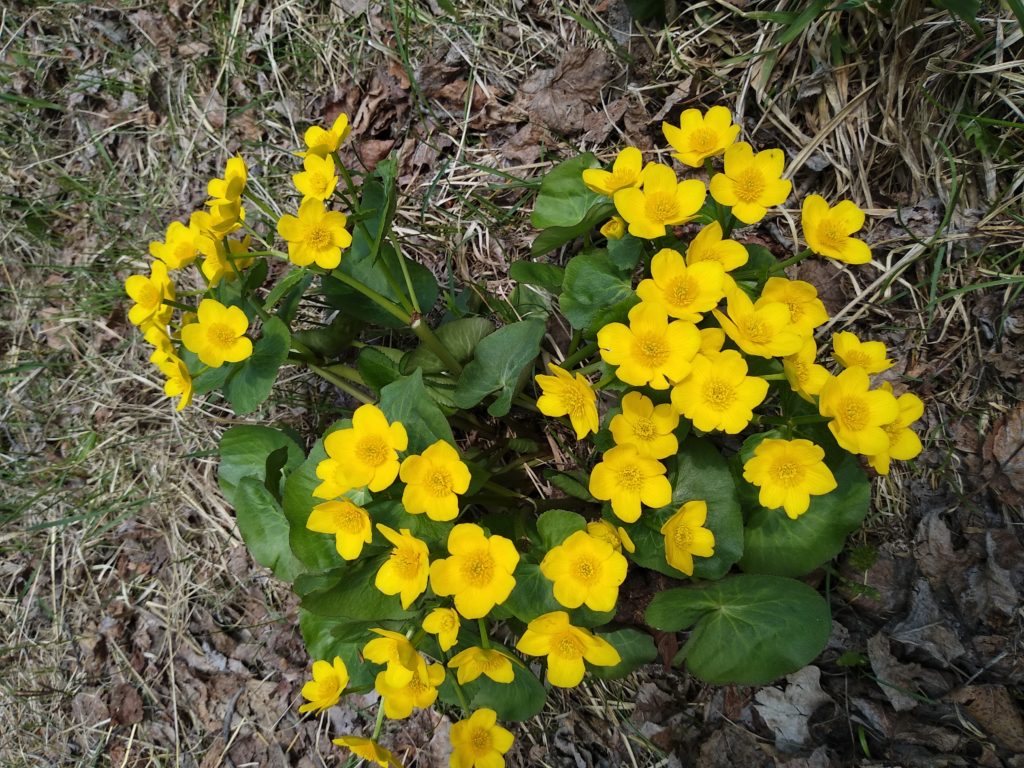
Marsh marigolds abounded along our hiking trail. Like many plants, however, if they’re flowering, you’re too late. The best time to harvest marsh marigolds is when they are young, with buds that haven’t yet blossomed into flowers.
A Note About Chaga Mushrooms…
As we walked with Kelley, she told us about a particularly interesting food to harvest: Chaga mushrooms. Sometimes used as a coffee replacement (I’ve seen it advertised that way at our local co-op), this mushroom can be harvested, ground down, and steeped in hot water to make an earthy, coffee-like beverage. The Chaga grows on birch trees and is so dark black that it appears to be burned. However, when you split it open, it’s insides are a rusty, golden color. Apparently, it is difficult to chisel the chaga off the tree, so bring a saw, a pick, or some other type of sturdy tool. Then, you’ll need to keep it in a bag as you pound it with a hammer (great stress reliever, sounds like!). After that, you’ll grind it down further with a coffee grinder or food processor to prepare it for brewing.
One tip about chaga mushrooms: it is best to harvest them in the fall or winter to get their full nutritional value. At this point, the tree has shut down its usual functions and some of its energy is being stored in the mushroom. ChagaHQ.com says, “Do not harvest chaga when the sap starts running and/or the summer months, as at this time the chaga will have as much as 80% water content and will be flushed of all its nutrients until the next fall.”
Fourth: Ramps (AKA Wild Leeks)
A favorite among chefs (and a pricey item at the farmer’s market!), we were able to find MANY clumps of ramps as we walked along the trail. Identify ramps by their slender stalk which is dark red at the base and fades to green. The leaves are smooth and glossy—they remind me of a typical houseplant.
When harvesting ramps, dig down under the bulbs with a spade. It may take some effort to loosen the soil around them if there’s bric-a-brac or roots in the soil. Gently abstract the bulbs (you’ll probably get four or five in a clump), because they are fit for consumption, along with the stems and leaves.
Fifth Forage Find: Spruce tips
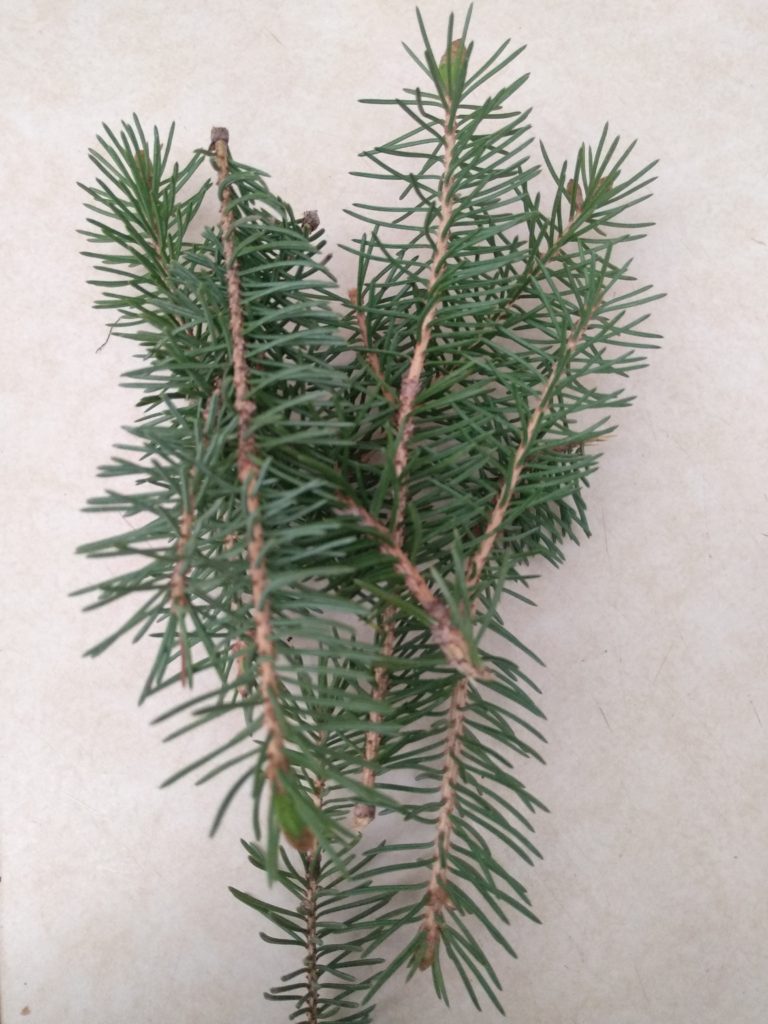
This one was probably the most surprising to me. I have been around spruce my entire life and had no idea they could be used to make tea. Harvest the very tips of the bough, but not the cones (or emerging cones). It is also possible to make evergreen tea out of fir, hemlock pine, or cedar (who knew??).
A FORAGED FEAST
After bringing back my foraged foods, I prepared them for consumption. On Kelley’s recommendation, I sautéed the fiddleheads, ramp bulbs, and ramp leaves (rough-chopped) in olive oil with a little salt and pepper. They were a hit! Everyone commented on how I could have substituted spinach and garlic, and they would never have known the difference.
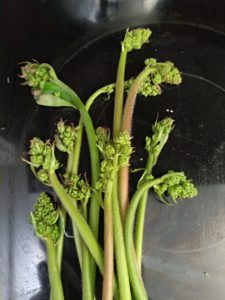
The swamp saxifrage was fit to serve raw, so I chopped off the ends and cut them into two-inch pieces. They also went over well, and I even used a few on my salad the next day.
The marsh marigolds were the only less-than-tasty foraged food. To get rid of the extreme bitterness, I had to boil them three times, swapping out the water each time to get rid of the acidity. In the end, they were mushy and still slightly bitter. Kelley called them “green pudding,” and said she would only eat them in a dire survival situation. Noted, and confirmed.
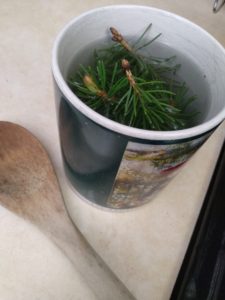
Lastly, I brewed a handful of spruce tips by putting them directly into a coffee cup and pouring boiling water over them. I let them sit for about ten minutes, popping in a cinnamon stick toward the end. I then strained out the spruce and served the tea. Everyone (myself included!) was pleasantly surprised by the refreshing, piney flavor.
To date, this is the most fun I’ve had learning a new set of survival skills. One of the best things I learned was how to think like a forager. You have to stay alert as you walk, your eyes scanning both the forest floor and trees. And you can’t be afraid to get off the trail and get dirty—that simply goes with the territory!
You’d better believe I’ll be back in the forest again soon.
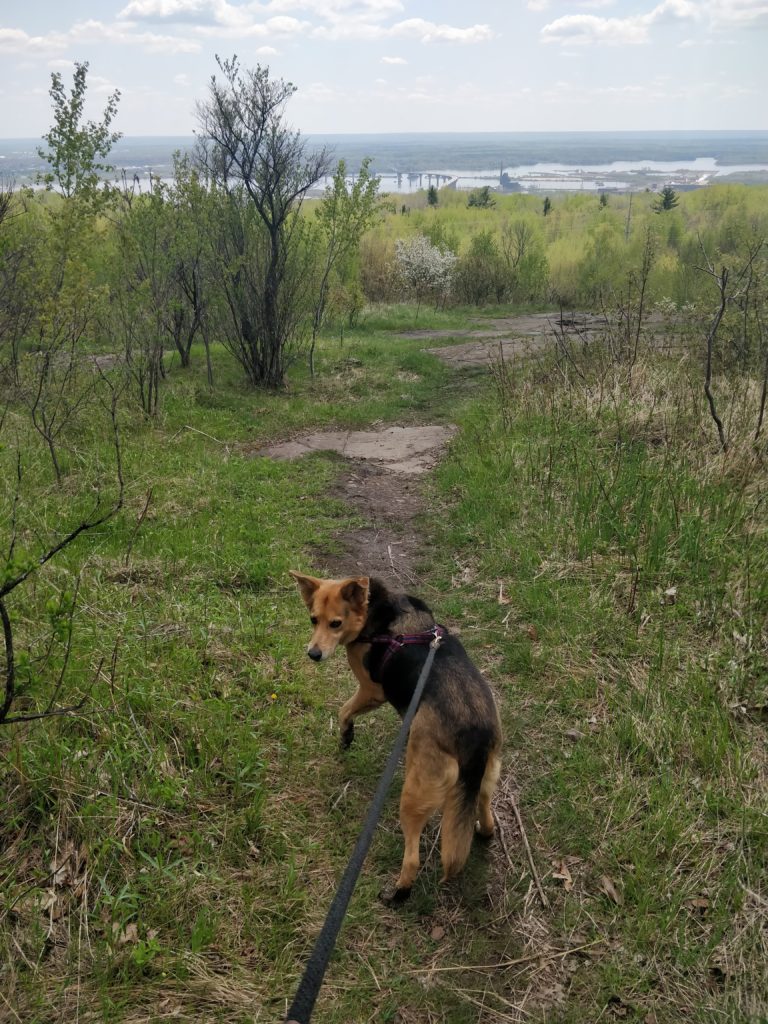
P.S. You might be wondering: “Where are the morels?” Great question. Morel mushrooms are a coveted food for foragers, and a tightly-guarded secret. Kelley claims she hasn’t found her own patch yet, and even if she has, I wouldn’t be offended if she didn’t want to share her secret location with me. It’s hard to keep a hidden morel patch under wraps for long. But maybe if I keep my eyes on the forest floor, I’ll find some down the road…
Author: KateBitters
Kate Bitters is a Minneapolis-based author and freelance writer. She is the author of Elmer Left, Ten Thousand Lines, and He Found Me. One of her proudest/nerdiest moments was when Neil Gaiman read one of her short stories on stage at the Fitzgerald Theater.
